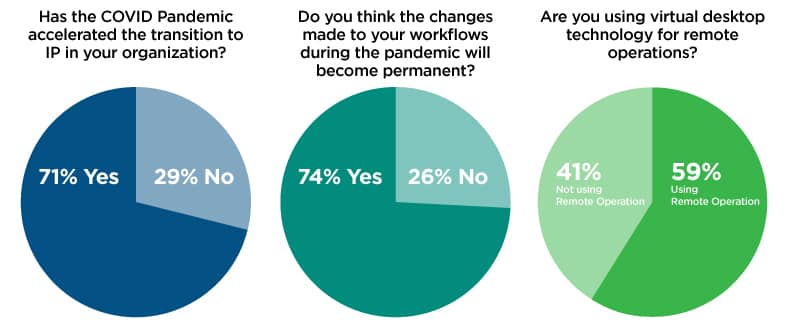Did you catch our recent webinar with Haivision’s partner EVS, and the NEP Group about remote replay workflows? In this post, we’re providing a quick recap on the blog of five key takeaways. With video experts from all three companies on the panel sharing their unique insights, it’s definitely worth a watch.
Takeaway 1: Enabling Remote Collaboration is a Big Challenge for Broadcasters
To set the scene, Marcus Schioler, our VP of Product Marketing and moderator of the webinar, kicked off the event with some interesting data points from Haivision’s recently published Broadcast IP Transformation Report 2021. Based on responses from over 500 television broadcast and video streaming professionals, the report provides some unique data points which explain some of the key market drivers we currently see in the industry. Of note, according to the report, because of the sudden reality of distributed workforces, 41% of broadcasters say enabling remote collaboration is a big challenge.
In addition, the report explores how the COVID-19 pandemic has accelerated IP transformation and whether the new ways of working and producing video content will become permanent. The report also delves into whether broadcasters are using virtual desktop technologies for remote operations.
 Key market drivers and trends in broadcast
Key market drivers and trends in broadcast
Takeaway 2: Decentralized Broadcast Workflows Are on the Rise
Jay Deutsch, Director of Media Solutions at NEP Group walks through the changes that NEP has made to the broadcast services it offers to customers over the past year – shifting from traditional remote productions (with OB trucks, as well as talent, operators, and management all onsite), to a new decentralized approach to covering live events. Decentralized and remote video production still requires some on-site equipment and camera crews, but the talent, technical operators, producers, and directors are now able to operate mobile units from home, no matter where they are located.
NEP Group is building workflows that promote efficiency and flexibility so team members can work anywhere – on-site at event venues or from remote locations including home offices or broadcast centers using a combination of EVS and Haivision technologies. NEP has already successfully designed and deployed workflows that include real-time streaming over the public internet for some of its clients, including major sports broadcasters in the US. Jay explains, that EVS replay operators working at-home can remotely control EVS XT playback servers located in a truck from their homes. Makito X4 video encoders deliver playback and multi-viewer content to remote operators with home-based Makito X4 video decoders for ultra low latency, high quality video monitoring.
Takeaway 3: EVS and Haivision have Joined Forces to Enable Remote Replay Workflows
EVS and Haivision recently announced a partnership so that together, they can bring broadcasters a combined, EVS certified solution that enables remote workflows for replay system operators for live sports broadcasting.
EVS is using Haivision’s Makito X Series of real-time video encoders and decoders to generate low latency, H.264 or HEVC encoded IP video streams from its XT-VIA live production servers located on-site to remote LSM-VIA controllers over any managed network or the public internet. This new integration essentially enables the extension of video monitors across long distances, even when working at resolutions up to 4K/UHD.
This new certified integration is part of EVS’ LiveCeption Signature solution and leverages the SRT (Secure Reliable Transport) streaming protocol, to ensure streaming of high-quality, full-frame-rate video to EVS remote operators at ultra-low latency. Comprised of three components, the LSM Via includes the remote control, the user interface (the clip screen where the operator adds their metadata), and the multi-viewer where the operator sees all their inputs and outputs. The multi-viewer is really important as this is how users interface with the remote control, press buttons, rewind, spool , or pause video, and where reactivity and responsiveness are critical. If there’s latency between pressing a button and the multi-viewer changing, this negatively impacts the operator.
This is where the partnership between EVS and Haivision comes into play, using Haivision Makito X4 video encoders and decoders, it’s possible to extend the monitoring plane that exists on the OB truck on the monitor wall to the at-home operator with ultra-low latency.
Takeaway 4: Latency Matters
Alex Redfern, SVP Solutions Architecture, EVS, explains that for remote replay operators working from home, the key consideration for a workable solution is latency. In this case, he defines latency as the difference between when you press the button and when the monitor changes in front of you. For certain remote operator scenarios, some degree of latency can be tolerated and does not necessarily present any issues, however for replay operators, too much latency renders a system unusable which is why reducing the latency for monitoring is critical. In his experience, the latency for replay operators has to be 500ms or less to be acceptable. Anything more than this for replay workflows, which need to be reactive, dynamic, and rapid, is simply hard to work with.
Selywn Jans, our very own Technical Video Solution Engineer, describes latency in terms of distance from a network perspective, or how many hops it takes to get from one destination to another within a network. He explains that the more we understand about our network, the more we can understand round trip time, packet loss, jitter, and the number of hops – all of which the SRT statistics can address by tuning or optimize a video stream. For example, knowing if there is bursty or continuous packet loss on a network can help predict the quality and latency needed to compensate for the stream. By leveraging the tools that SRT offers, and which are native to Haivision solutions, to their advantage, users can receive a high quality, low latency stream.
Takeaway 5: Remote Operation is Here to Stay
The panel discussed the fact that more remote operators (not just EVS operators) are looking to continue to work from home, with many of them starting to invest in their own equipment for their home setups. They want to be ready for the new normal and ready for the future. As Alex notes, whether they are freelancers or in-house staff, many broadcasters are seeing that when using this remote model, the quality of operators and thus the quality of their shows are improving. Without the need to travel, operators are able to work on more shows and the more practice they’re getting, the better and more consistent they are with their craft and as a result, the shows are improving. This applies to all types of remote operators, not just replay.
Jay believes remote operation is only going to get more common. “When you can put a remote position in someone’s home and they can contribute to a show successfully, do you really think that every one of those remote operators is going to return on-site? I’m going to say no. We’re going to see a lot more hybrid approaches. I don’t think there’s any turning back.”

